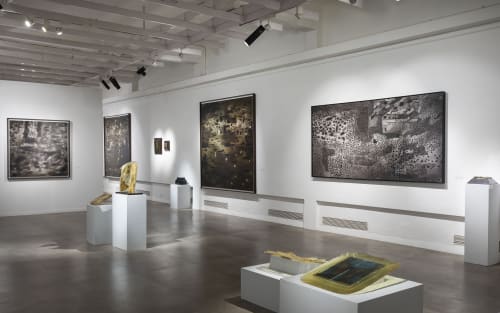In his gentle, reticent way, Rameshwar Broota has long been a commanding presence on the Indian art scene. His paintings communicate the same combination of a contemplative stillness with an aura of monumentality, even when his imagery and techniques are anchored in conditions of anxiety, anguish, trauma or catastrophe. […]
At first, breathtaking glance, Broota’s abstract paintings – made between 2020 and 2023 – enthral us with what can only be described as their spartan sumptuousness. Austerely created through the artist’s scratch technique –he only ever uses Bharat shaving razor blades, each one broken in half in a special device of his own invention – these painted surfaces are only deceptively monochromatic or dichromatic. The blade transforms each surface into a palimpsest, summoning up, to the level of visibility, hints of the lavish red and rich brown that lie beneath. Indeed, these painted surfaces are in a constant state of activation, with visual prompts, spatial triggers, evolving geometries of axis and tangent, and a dispersal of motifs casting their spell on the gaze.
Perhaps these paintings are best parsed as architectures of momentum. Within each of them, an impulse towards ceaseless mobility and contends with an equal and opposite impulse towards structural stability. These paintings are expansive and monumental in scale; their details, however, are not restful. They are populated by floating objects that propose a world of building blocks and tools that refuse, however, to cohere into patterns. Instead, in these frames, we find ourselves surrendering to the continuous rhythm established by the emergence and evanescence of forms, the interlocking and coming apart of vector forces. Might it be useful to regard Broota’s abstract paintings as laboratories for thought experiments concerning gravity and lightness, luminosity and darkness, tactility and resonance?
Excerpt from the essay Architectures of Momentum by Ranjit Hoskote

